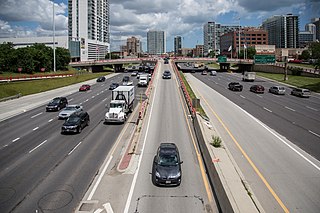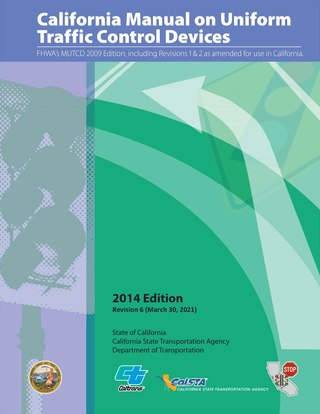
A highway is any public or private road or other public way on land. It is used for major roads, but also includes other public roads and public tracks. In the United States, it is used as an equivalent term to controlled-access highway, or a translation for autobahn, autoroute, etc.

A high-occupancy vehicle lane is a restricted traffic lane reserved for the exclusive use of vehicles with a driver and one or more passengers, including carpools, vanpools, and transit buses. These restrictions may be only imposed during peak travel times or may apply at all times. According to the criteria used there are different types of lanes: temporary or permanent lanes with concrete barriers, two-directional or reversible lanes, and exclusive, concurrent, or contraflow lanes working in peak periods. The normal minimum occupancy level is two or three occupants. Many jurisdictions exempt other vehicles, including motorcycles, charter buses, emergency and law enforcement vehicles, low-emission and other green vehicles, and/or single-occupancy vehicles paying a toll. HOV lanes are normally introduced to increase average vehicle occupancy and persons traveling with the goal of reducing traffic congestion and air pollution.

Carpooling is the sharing of car journeys so that more than one person travels in a car, and prevents the need for others to have to drive to a location themselves.

Rumble strips are a road safety feature to alert inattentive drivers of potential danger, by causing a tactile vibration and audible rumbling transmitted through the wheels into the vehicle interior. A rumble strip is applied along the direction of travel following an edgeline or centerline, to alert drivers when they drift from their lane. Rumble strips may also be installed in a series across the direction of travel, to warn drivers of a stop or slowdown ahead, or of an approaching danger spot.
The Virginia Department of Transportation (VDOT) is the agency of the state government responsible for transportation in the state of Virginia in the United States. VDOT is headquartered at the Virginia Department of Highways Building in downtown Richmond. VDOT is responsible for building, maintaining, and operating the roads, bridges, and tunnels in the commonwealth. It is overseen by the Commonwealth Transportation Board, which has the power to fund airports, seaports, rail, and public transportation.
The Midwest Roadside Safety Facility is a research organization in Lincoln, Nebraska that conducts automotive crash testing. MwRSF is operated by the University of Nebraska–Lincoln (NU) and researches highway design and safety with a particular emphasis on safety performance evaluations of roadside appurtenances. Since its establishment in 1974, the facility has evaluated existing barriers and frequently developed new design concepts and technologies for use on public roadways.

The Texas Department of Transportation is a Texas state government agency responsible for construction and maintenance of the state's immense state highway system and the support of the state's maritime, aviation, rail, and public transportation systems. TxDOT previously administered vehicle registration prior to the creation of the Texas Department of Motor Vehicles in November 2009.

A Texas T, also called a T-ramp, is a T-shaped highway ramp that combines entrance and exit ramps into a single structure that allows entrance and exit to the left (inside) lanes of an expressway. It is intended to avoid traffic congestion caused by large numbers of high-occupancy vehicles crossing several lanes near exits.
The Transportation Research Board (TRB) is a division of the National Academy of Sciences, Engineering, and Medicine, formerly the National Research Council of the United States, which serves as an independent adviser to the President of the United States, the Congress and federal agencies on scientific and technical questions of national importance. It is jointly administered by the National Academy of Sciences, the National Academy of Engineering, and the National Academy of Medicine.

The Texas Department of Transportation (TxDOT) is a governmental agency and its purpose is to "provide safe, effective, and efficient movement of people and goods" throughout the state. Though the public face of the agency is generally associated with maintenance of the state's immense highway system, the agency is also responsible for aviation in the state and overseeing public transportation systems.
The Bluffton University bus crash was an automobile crash that occurred during the early morning hours of March 2, 2007, on Interstate 75 in Atlanta, Georgia. A chartered motorcoach was carrying 33 members of the Bluffton University baseball team from Bluffton, Ohio, on their way to play Eastern Mennonite University during spring break in Sarasota, Florida. The group planned to travel without an overnight stop on the approximately 900-mile, 18-hour trip. The trip went without incident from Bluffton south to a motel in Adairsville, Georgia, at which time a relief driver began operating the bus for the second half of the trip.

Active traffic management is a method of increasing peak capacity and smoothing traffic flows on busy major highways. Techniques include variable speed limits, hard-shoulder running and ramp-metering controlled by overhead variable message signs. It has been implemented in several countries, including Germany, the United Kingdom and the United States.

The Highway Capacity Manual (HCM) is a publication of the Transportation Research Board (TRB) of the National Academies of Sciences, Engineering, and Medicine in the United States. It contains concepts, guidelines, and computational procedures for computing the capacity and quality of service of various highway facilities, including freeways, highways, arterial roads, roundabouts, signalized and unsignalized intersections, interchanges, rural highways, and the effects of mass transit, pedestrians, and bicycles on the performance of these systems.
Trinity Industries Inc. is an American industrial corporation that owns a variety of businesses which provide products and services to the industrial, energy, transportation and construction sectors.
The American Road & Transportation Builders Association (ARTBA) is a trade association representing the transportation construction industry in the United States and is based in Washington, D.C., United States.

A high-occupancy toll lane is a type of traffic lane or roadway that is available to high-occupancy vehicles and other exempt vehicles without charge; other vehicles are required to pay a variable fee that is adjusted in response to demand. Unlike toll roads, drivers have an option to use general purpose lanes, on which a fee is not charged. Express toll lanes, which are less common, operate along similar lines, but do not exempt high-occupancy vehicles.
Sidra Intersection is a software package used for intersection (junction), interchange and network capacity, level of service and performance analysis, and signalised intersection, interchange and network timing calculations by traffic design, operations and planning professionals.

A managed lane is a type of highway lane that is operated with a management scheme, such as lane use restrictions or variable tolling, to optimize traffic flow, vehicle throughput, or both. Definitions and goals vary among transport agencies, but managed lanes are generally implemented to achieve an improved operational condition on a highway, such as improving traffic speed and throughput, reducing air pollution, and improving safety. Types of managed lanes include High-occupancy vehicle (HOV) lanes, High-occupancy toll lanes, express toll lanes, reversible lanes, and bus lanes. Most managed lane facilities are located in the United States, although HOV and bus lanes can be found in many other countries; outside of the US, many countries use active traffic management that manage all lanes of a highway.
Kumares C. Sinha is an Indian-American engineer, researcher and educator known for contributions to transportation systems analysis, transportation infrastructure economics and management, transportation safety, and the use of emerging technologies in transportation. He has served as Edgar B. and Hedwig M. Olson Distinguished Professor of Civil Engineering at Purdue University. since 1998.

The California Manual on Uniform Traffic Control Devices is the standard for traffic signs, road surface markings, and traffic signals in the U.S. state of California. It is developed by the California Department of Transportation (Caltrans) Division of Safety Programs "in substantial conformance to" the national Manual on Uniform Traffic Control Devices developed by the Federal Highway Administration. The first edition of the CA MUTCD was published in 2006, replacing an earlier supplement to the national MUTCD. The most recent edition was published in 2014, incorporating the 2009 edition of the national MUTCD. California is one of ten states that publish their own editions of the MUTCD. The CA MUTCD defines the content and placement of traffic signs. Design specifications are detailed on a section of the Caltrans website that is based on the national Standard Highway Signs and Markings (SHSM) document.












